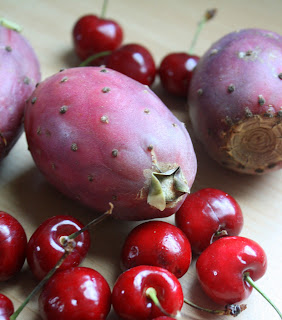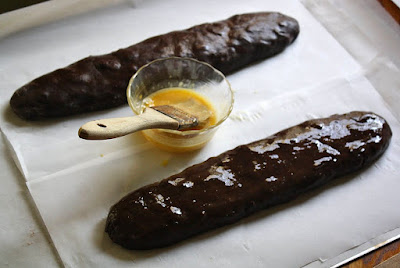A few short weeks ago, I was sitting in a dim and cozy restaurant gabbing with my pastry-school pal, Michelle. She'd just handed me about six luscious pounds of thin couverture-chocolate disks that she'd acquired wholesale through one of her mysterious culinary connections. Two big bags of the disks were parked on the table when the waitress came over to greet us. She glanced curiously at the bulging sacks and said, "What's
this?"
I think she may have feared we brought our own bag-lunch because, for an instant, she got that wary-waitress gleam in her eye. You know the gleam I mean? Anyway, Michelle, who is smart as a whip and takes no guff from
anyone, quipped, "I'm a drug dealer." Then after a pregnant pause she added, "It's
chocolate."
The waitress immediately chuckled, smiling in understanding. Chocolate. Of course. We were speaking the universal language.
One of the nicest benefits of attending culinary school has been the opportunity to meet kindred spirits, Michelle being one of them. It was from her that I got the notion to make panettone this Christmas season.
(Michelle, you constantly generate good ideas for baking and pastry shenanigans. I love that about you!)
And, I had another incentive to make panettone this holiday season as well. I received a complementary case of chopped candied fruit a couple of weeks ago from the
Paradise Fruit Company of Plant City, Florida. I'm pretty sure I yelped in surprise when I unsealed that cardboard carton only to find all those containers of candied orange peel, lemon peel, citron, and crystallized ginger. I don't know what I thought might be in there, but it wasn't candied fruit.
I opened one of each. They all looked and smelled
so fresh. I tried citron first. I'd never tasted citron before, candied or otherwise, and the first thing I noticed is that it's beautifully translucent. Light shines right through.
As I nibbled each variety of fruit, my preconceived candied-fruit notions were blown out of the water. All of the lovely, sticky, little cubes were so bright. The orange- and lemon-peels were so chewy, and the candied ginger was
just right--not too peppery, and not at all bitter.
I'm now officially a candied fruit believer, and panettone is the perfect vehicle for quality candied citrus. Many, many thanks to
Paradise Fruit for offering me this wonderful sampling. I love it!
About this recipe . . .
The recipe I chose is pretty elementary compared to the more
elaborate, old-school panettone versions out there. This is an I-don't-have-all-the-time-in-the-world-but-I-really-want-to-make-panettone formula. Adapted from a recipe in the latest issue of the
King Arthur Flour catalog, this citrus panettone begins with a starter that you toss together the night before.
What did I change? Well, the main recipe calls for 1/4 cup of potato flour, but I didn't have that so I substituted 1/2 instant potato flakes; this is a common substitution used in bread recipes, and not to be feared. I didn't have the special flavoring called for (Fiori di Sicilia), so I made my own tiny mixture of vanilla, lemon, orange, and almond extracts. I didn't have one of those
traditional paper panettone pans in the correct size (though I drove around metro Detroit looking for them, to no avail!), so I used two high-sided metal cake pans (6" x 3") and they worked out just fine. And, of course, I rewrote the instructions to reflect exactly what I did.
This panettone is slightly sweet with a gloriously tender crumb of the palest yellow.
Yum.
Triple Citrus Panettone
(For a printable version of this recipe click here!)
Yield: Two smaller loaves (mine were 4" tall and 6" wide); or one larger loaf
Ingredients for the starter:
1 cup unbleached all-purpose flour
1/16 teaspoon instant yeast
1/2 cup (4 fluid ounces) cool water
Ingredients for the dough:
2 cups (8.5 ounces) unbleached all-purpose flour
1/2 cup instant mashed-potato flakes
(I used Hungry Jack brand, natural flavor; alternately, you can use 1/4 of potato flour.)
1/4 cup granulated sugar
1 and 1/4 teaspoons salt
(I used fine sea salt.)
2 teaspoons instant yeast
1/4 cup (2 fluid ounces) lukewarm water
2 large eggs, room temperature
6 tablespoons (3 ounces) unsalted butter, room temperature
1/4 teaspoon vanilla extract
A couple drops each of orange extract, lemon extract, and almond extract (enough to equal 1/4 teaspoon total)
1 cup mixture of candied orange peel, lemon peel, and citron, all chopped into very small cubes
(I used Paradise Fruit brand; it's already cut to the perfect size.)
Make the starter the night before you make the bread dough:
In a medium-size bowl, combine the flour, yeast, and water. Cover bowl with plastic wrap. Leave at room temperature, undisturbed, until the next morning. The starter will get slightly bubbly.
Make the bread dough:
Measure all of the dry ingredients for the dough into a large bowl; whisk them together lightly.
Add in the wet ingredients (except for the candied fruit; that goes in last) and stir until well combined combine.
Mix in the candied fruit until well distributed.
Mix by hand for a couple of minutes (I easily did this by hand with a dough-whisk; you can use a mixer with the paddle attachment, on low speed, if you prefer) then dump the dough out onto a floured surface and gently knead it for another minute or two. It should be soft and sticky.
Put the dough into a large bowl that's been sprayed with vegetable spray or lightly oiled with vegetable oil.
Cover the bowl with a sprayed/oiled piece of plastic wrap, and top that with a lightweight dish towel. Let the dough rise in a warmer-than-room-temperature spot for up to 90 minutes, until it's almost doubled (don't expect to see dramatic rise).
Turn the risen dough out onto a very lightly floured work surface. Gently deflate it. If you're making two smaller loaves, divide the dough now with a bench knife or sharp chef's knife. Shape the dough pieces into smooth balls and pinch closed any bottom seams.
Place the dough balls into pans that have been well greased with shortening (I used two 3"x 6" metal cake pans), or into paper panettone pans. Cover the pans with sprayed/oiled plastic wrap and top that with the lightweight dish towel.
Put them in a warm spot and let them rise for up to 2 hours, until almost doubled.
Preheat the oven to
375 degrees.
Remove the plastic wrap carefully so as not to deflate the dough and place the pans in the middle of the hot oven (I placed my pans atop a baking sheet to help ensure the bottom of the loaves wouldn't burn).
Bake for 15 minutes, then turn the oven down to
350 degrees. Continue baking for 15 to 20 more minutes, or until the loaves are deep golden all over. If you're baking one large loaf, you may need to bake for 35 minutes longer.
Remove the finished loaves from their pans immediately and cool them completely on a rack before slicing.
(If you'd like to comment on this post, or to read any existing comments, please click on the purple COMMENTS below.)





















































































